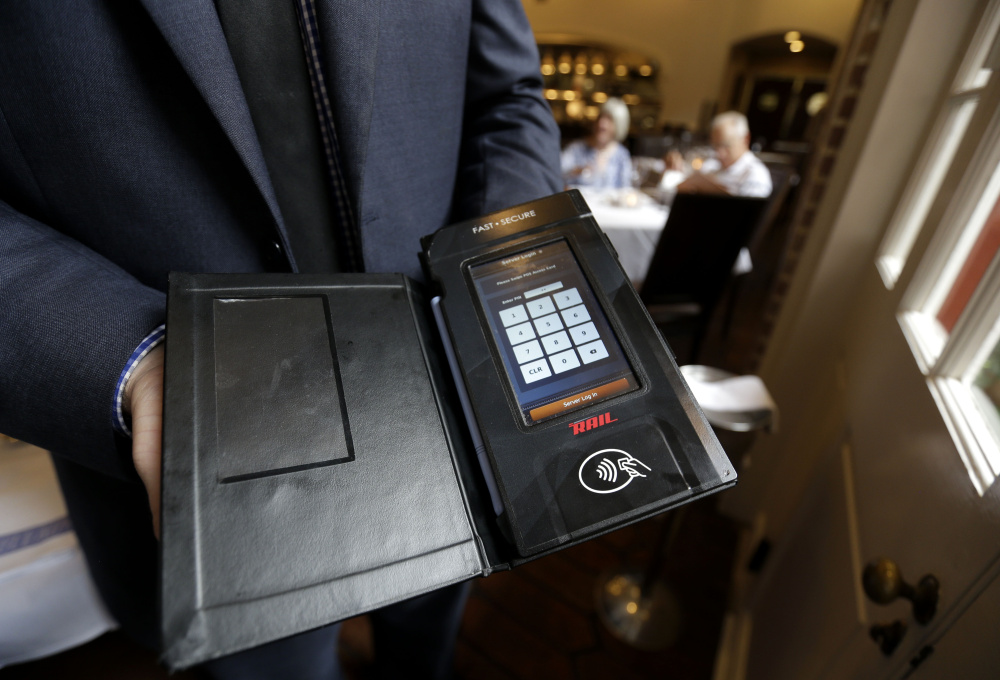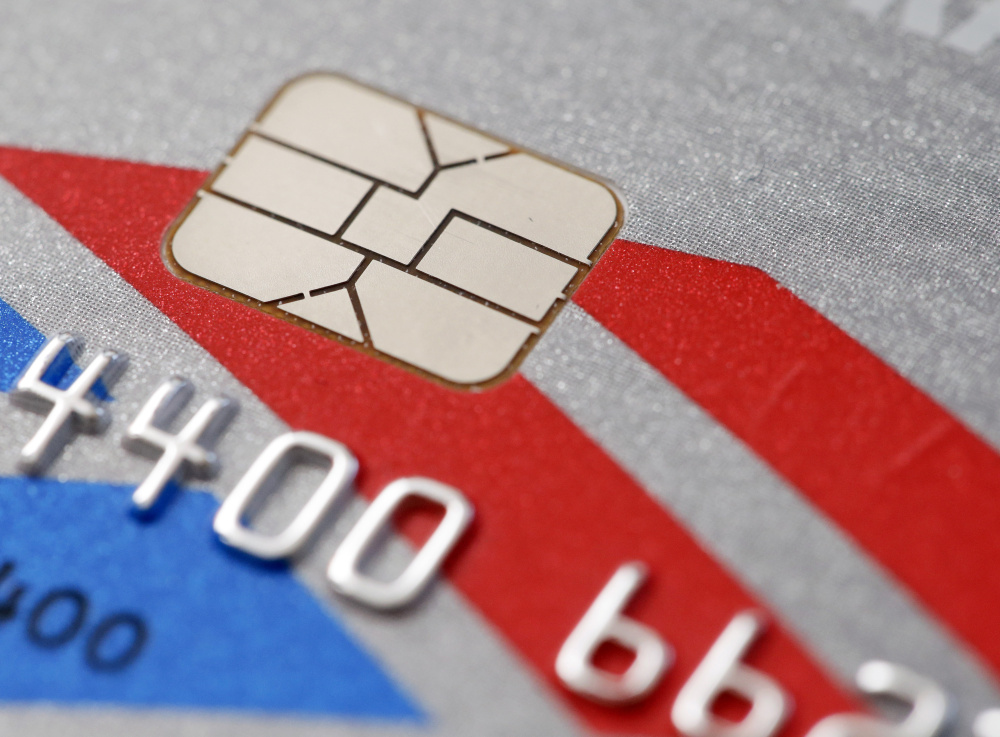Thursday is the deadline for retailers who accept MasterCard and Visa to start using payment card readers that scan embedded microchips to avoid liability for fraudulent purchases. But don’t expect them to roll out the technology all at once.
Businesses in Maine are in various stages of installing the new readers at checkout counters, and many consumers have yet to be issued the chip-embedded cards.
The transition from using existing magnetic-strip readers that require consumers to swipe their card, to chip readers that require “dipping” the card into a slot, is taking time and money, said banking and retail representatives. The process involves installing new hardware and software, as well as obtaining a certification from the card issuers.
Several large chain retailers such as Best Buy already have completed their Maine rollout of the chip readers. Bart Gillespie, general manager at Best Buy’s Maine Mall location in South Portland, said the store began using the readers about a week ago.
The new chip readers are designed to thwart criminals who try to purchase goods in person using stolen card numbers by making the cards themselves more difficult to counterfeit. However, retailers will continue to allow customers without chipped cards to swipe the old-fashioned way, at least until every consumer has been issued chip-embedded cards.
Other retailers such as Hannaford Supermarkets have installed the new hardware but still are in the process of implementing the software required to unlock its chip-dipping functionality.
“We’ve successfully installed the chip readers in all of our stores,” said Hannaford spokesman Eric Blom. “We’re still working on some software issues related to that.”
He said the supermarket chain does not yet know when it will start using the new system.
Many small businesses in Maine have yet to install the chip readers, which cost $300 to $600 each, said Curtis Picard, president of the Retail Association of Maine. There is no requirement that retailers install them immediately, he said, but those that don’t could be liable for fraudulent purchases made at their stores.
“They’re getting there,” Picard said. “They are definitely taking this seriously.”
SHIFTING LIABILITY FOR FRAUD
The new readers are an attempt to use technology to thwart fraud and to shift responsibility for covering the cost of the theft when it does occur. Consumers are protected by law, which makes them liable for no more than $50 of any unauthorized purchase. Historically, banks have been left to cover the cost of the fraudulent purchase and make the retailer whole. Card issuers have accepted liability for all fraud, but have argued that it is unfair in situations involving lax security on the retailer’s part.
Now if a retailer fails to use a chip reader and a fraudulent purchase is made using a chip-embedded card, it’s the retailer who suffers the loss. If a card with no chip is used to commit fraud, then the bank accepts responsibility even if the retailer does not have a chip reader.
Just as many retailers have yet to implement the technology, several financial institutions in Maine are still working on issuing chip-embedded cards to all of their customers.
As eager as banks are for the new system to be implemented fully, progress has been relatively slow because card manufacturers are overwhelmed with the volume of requests to produce chip-embedded cards, said Chris Pinkham, president of the Maine Bankers Association.
“Each batch that is manufactured has to be tested, and that is part of the backlog,” he said.
John Murphy, president of the Maine Credit Union League, said no one expected banks and financial institutions to be ready for full compliance by Thursday’s deadline.
“It’s a process that takes a long time,” he said.
Chipped cards cost financial institutions more, Murphy said, and there are bottlenecks in the rollout process such as the backlog of orders at the card manufacturers. Likewise, MasterCard and Visa have a backlog of retailers waiting for the two major card issuers to certify their new chip-reading systems, he said.
According to a CreditCard.com survey in early September, only 40 percent of cardholders had received a chip-embedded card, and credit card companies have been unable to grant the necessary software and payment-terminal certifications to stores fast enough to meet the deadline, according to the National Retail Federation.
DIPPING TAKES LONGER THAN SWIPING
The transition to chip readers also will require an adjustment on the part of consumers, Picard said. Dipping a chipped card takes five to 10 seconds longer than swiping a striped card, he said, which is bound to seem like a long time to shoppers accustomed to near-instantaneous approval.
“That’s going to be a little bit of a learning curve for consumers … because it does take longer,” Picard said.
Retailers would have preferred the implementation of a second layer of fraud protection used in Europe, Canada and other parts of the world that requires holders of chipped cards to enter a personal identification number similar to those used with debit cards, he said.
Still, Pinkham said other countries that have implemented “chip and PIN” security generally began with the chip technology and then added the requirement for numerical codes later.
The retail federation said many retailers are implementing additional security measures above and beyond those required by the banks, such as encryption to protect consumers’ financial data.
The new system is not foolproof, the industry representatives said, but it should help reduce the amount of economic damage from major payment-card-data breaches such as those that occurred at Target and Home Depot.
“We are very much looking forward to full implementation,” Murphy said.
Send questions/comments to the editors.





Success. Please wait for the page to reload. If the page does not reload within 5 seconds, please refresh the page.
Enter your email and password to access comments.
Hi, to comment on stories you must . This profile is in addition to your subscription and website login.
Already have a commenting profile? .
Invalid username/password.
Please check your email to confirm and complete your registration.
Only subscribers are eligible to post comments. Please subscribe or login first for digital access. Here’s why.
Use the form below to reset your password. When you've submitted your account email, we will send an email with a reset code.